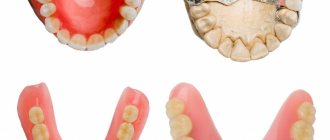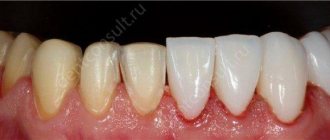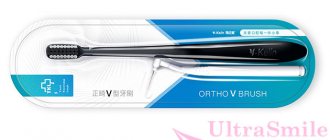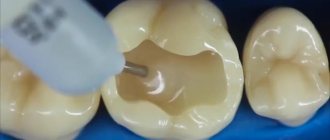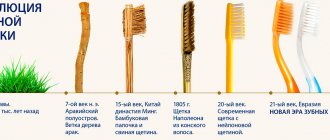- What are veneers
- Indications and contraindications
- Features of the installation process
- Service life of veneers depending on type
A service such as the installation of veneers is becoming increasingly popular in dental clinics. This is a method of dental reconstruction that has a rather aesthetic purpose. As a result of the procedure, the teeth acquire the correct shape and color. This type of dental service is not cheap, so the question of how long veneers last on teeth is quite relevant. There are many features that affect the service life of veneers, it is better to learn about them before the procedure.
What you can and cannot eat after installation of veneers and lumineers
If you have veneers and lumineers, the most important thing is to limit the load on the front teeth. That is, give up anything solid—excessive pressure can cause the plates to crack or peel off.
- do not bite off any food, even the softest. You need to get used to cutting or separating foods into small pieces - this applies to vegetables, fruits, meat, crackers and even cookies. Chew only with lateral teeth without overlays,
- give up the seeds - at least peel them by hand and chew them with your side teeth,
- use fibrous foods with caution - they can get stuck in the interdental spaces - it will be quite difficult to remove them with dental floss,
- it is necessary to abandon “coloring” foods (beets, red wine, black tea, coffee) or minimize their consumption, since the risk of changing the shade of dentures, especially composite and ceramic ones, significantly increases,
- Sudden changes in temperature (first eating hot meat, then drinking it with cold milk) are prohibited, as are too hot or cold foods and drinks - this can lead to cracks in the material and resorption of the composite glue. Ultimately, the overlay will simply come off.
There is absolutely no difference between veneers and lumineers in terms of care. They are fixed equally well, but veneers may fit the gum a little less tightly - the thicker the plate, the more “step” remains between the veneer and the mucous membrane. It can chafe and cause inflammation. Therefore, it is the gums that need to be given the most attention after restoration.
Service life, care rules and price
Experts recommend changing the material every five years, as it is quite fragile, wears out quickly and loses its original appearance. To reduce the likelihood of cracking, it is necessary to properly care for composite veneers. To extend the service life of products, it is recommended:
- brush your teeth and veneers every day, paying special attention to the joints;
- use an irrigator and other devices to get rid of food debris in hard-to-reach places;
- regularly go to the doctor to polish the surface;
- refuse solid food and dyes, avoid mechanical damage;
- if you have bruxism, use special mouth guards designed for night use.
Composite linings may differ in cost, the difference in price is due to the following factors:
- level of service and professionalism of specialists;
- diagnostic methods;
- need for additional treatment;
- cleaning and processing method;
- type of anesthesia during turning;
- direct or indirect installation method;
- quality of materials used.
Thus, a classic composite costs about 1,500 rubles, and a more modern one - 9,000. If we compare Moscow clinics, the economy class of services will cost 3,000 for a restoration, and in a prestigious institution the cost for the entire procedure can be 15,000.
They have an attractive appearance, they correct some pathologies well and can last quite a long time. Every person wants to have a beautiful smile, and modern techniques involve making veneers from different materials, but composite is the best solution.
What hygiene products should you have in your arsenal?
Hygiene products after installation of veneers and lumineers
| Name | Description |
| Toothbrush | Only with soft bristles - use it to clean the very surface of veneers and lumineers. Too hard hairs can lead to cracks. The teeth themselves can be brushed with a regular, medium-hard brush. Do not use electric brushes specifically for teeth with veneers - vibration can lead to the veneers coming off. Again, such brushes use quite aggressive bristles and even plastic elements that can damage the material and make it rougher - you should definitely avoid such attachments. |
| Toothpaste | Without the addition of abrasive particles (not bleaching!), such a paste can also lead to the formation of microcracks on the surface of the dentures. |
| Irrigator | Allows you to clean both the interdental spaces and the surface of the veneers from plaque. An additional bonus is a massage of the gums - the mucous membranes are saturated with oxygen, metabolic processes in them are restored. |
| Mouthwash | Choose the product that you need, taking into account your existing problems: to combat gum inflammation, to reduce tooth sensitivity, to strengthen enamel (with fluoride). |
Basic recommendations
The rules for caring for veneers after their installation are no different from the basic requirements for oral hygiene in general.
A person does not need to change the organization and plan for allocating temporary resources for the day or constantly carry toothpaste, brush and mouthwash. But a number of important nuances must be taken into account.
The first thing you should pay attention to after restoration is nutrition. The consumption of products containing aggressive dyes (coffee, chocolate, beets, red wine) must be minimized. It is not necessary to completely exclude such food from the table, it is enough to simply reduce its consumption.
This is interesting: Immediate prosthesis, what it is needed for, types, pros and cons, service life and care
Smoking with veneers is prohibited , otherwise nicotine, with its harmful effects, can quickly turn the snow-white color of beautiful teeth into a yellowish tint.
Remember, aesthetic veneers are not protective elements for teeth, so you should not overload them with excessive chewing pressure.
Avoid cracking seeds, cracking nuts, or using your teeth as a bottle opener. All this can compromise the integrity of the veneers and harm healthy units.
Active sports require the installation of a special protective mouthguard that will protect the pads from mechanical damage.
Let us consider in detail the important nuances of caring for veneers.
How to brush teeth with veneers?
- Replace all hard brushes with soft or ultra-soft ones. Rough bristles can damage the surface. The same applies to toothpastes with abrasive particles, the so-called whitening ones.
- Dental floss and irrigator should be used as often as possible, every time after eating. It is important to remove food particles and accumulated plaque very carefully so that it does not get clogged into microcracks and the gap between the gums.
- Don't neglect your mouthwash. Any one is suitable for strengthening gums or sensitive enamel.
- Professional teeth cleaning is recommended every three months. It is better to do it in high-level dentistry, where they know exactly how to work with this type of veneers.
Patients after microdental prosthetics are always warned about possible problems with the gums. If you neglect hygiene, the risk of developing inflammation at the junctions with the mucous membrane increases. Any irritation, swelling or redness is a reason to consult your specialist. Otherwise, the process will go too far and then you will have to remove the veneers until the gums heal.
Did you notice roughness on the surface, did it seem that the lining was not tightly attached to the tooth? Go to the dentist immediately. The doctor will be able to assess the extent of the damage and attach the veneer to the tooth. Otherwise, plaque will accumulate in the cracks, which will cause caries. Then you will definitely have to remove the plates and wait until the tooth is treated.
Using an irrigator
An irrigator is what you need if veneers are installed in the oral cavity. Using it, you raise the quality of teeth cleaning to a higher level. The irrigator can clean 2 times more plaque than a regular toothbrush. It cleans not only the surfaces of the teeth, but also the places where the dentures are adjacent to them, as well as the mucous membrane of the gums and tongue.
The operation of the device is based on the principle of supplying liquid under pressure through a special nozzle. The jet directed at the tooth perfectly washes away plaque and massages the gums, stimulating blood circulation.
Dietary restrictions
The condition of veneers is negatively affected not only by the coloring and hard foods mentioned above, but also by highly acidic foods. For this reason, dentists strongly recommend making minor adjustments to your daily diet.
Remarkable! You should eat fibrous foods with caution, because... it can get stuck in the spaces between the teeth, and eliminating it even with the help of special devices is quite problematic.
If dental floss is used for these purposes, it is important not to place it vertically, i.e. do not move from the gums to the edges, so as not to damage the aesthetic pads.
Caring attitude
Taking good care of veneers involves, first of all, avoiding impacts and injuries.
Also, after the restoration procedure, a person with a Hollywood smile needs to be regularly seen by a dentist. If rough areas appear on the products, unevenness is an alarming signal to immediately visit the clinic. Such defects are potentially dangerous and can cause the development of caries and other serious diseases.
Patients suffering from bruxism should pay close attention to the care of the plates. This disease is a contraindication to the installation of onlays, however, if restoration and restoration of teeth in this way was necessary, it is important to wear a special mouthguard while sleeping at night.
It is necessary to visit the dentist periodically for professional teeth cleaning. Only a specialist can qualitatively remove plaque that has been left unattended in the most inaccessible areas of the dentition.
Visiting the dentist
Even if you are 100% sure that you are taking the best possible care of your teeth, be sure to visit your dentist at least twice a year and schedule a professional teeth cleaning every 3 months.
Regular medical examinations and oral health checks by a qualified hygienist help to recognize emerging problems early. It is advisable to consult a doctor who has experience caring for veneers.
This is interesting: What is better: an implant or a crown - for a tooth, reviews
How to properly brush teeth with veneers and lumineers
There is nothing special here: in the morning before breakfast and in the evening after all meals using a brush (how to choose it - see the sign above) and paste. Complete the complex with the use of an irrigator, and finally rinse the mouth with mouthwash.
After each meal, it is mandatory to remove any leftover food. Preferably again with the help of an irrigator. It is important to maintain the condition of not only the veneers, but also the teeth underneath them, as well as the gums. Remember that even with dentures, teeth are destroyed - you can simply lose them.
Benefits of veneers
The main advantages of veneers include:
- Stain resistance: The surface of veneers is smooth, impenetrable and glazed - it does not stain.
- Good biocompatibility with gum tissue: veneers do not cause irritation, allergic reactions are very rare [1].
- Durability: Veneers can last 10 years or more with good hygiene and regular dental care.
- Full imitation of tooth enamel: veneers are completely transparent. Light falling on the surface penetrates to a certain depth inside the ceramics and is then reflected from the dental tissues. Therefore, externally the structure is no different from neighboring teeth.
- Impeccable mechanical strength: veneers are resistant to variable and multi-vector loads (shear, fracture, rupture, stretching and torsion). Strength is achieved by observing a certain proportionality of the components of the composition and special production technology - firing and fritting.
- Quick installation: the dentist will install composite veneers in one visit; ceramic ones will take about a week (examination, fitting of temporary veneers, fixation of permanent veneers).
- Relatively easy hygienic care thanks to the perfectly smooth surface.
When installing veneers, a complex result is achieved - teeth whitening, improvement of their shape, alignment of the dentition, elimination of various defects, such as chips, cracks, wide interdental spaces, and the consequences of fluorosis [1].
The production of veneers is contraindicated or undesirable if the patient’s dental system is functionally insufficient.
Prosthetics in the absence of teeth in the lateral sections or restoration of their chewing efficiency should be a priority task for the dentist. The basic rule is that before dealing with aesthetics, it is necessary to restore function. Naumovich S. A., Doctor of Medical Sciences, Professor [3]
Can I use dental floss?
There are no clear prohibitions on the use of dental floss and interdental brushes, but you need to be extremely careful when using them. After prosthetics, microgaps between teeth are naturally preserved. But here it is very important not to move the thread from the gums to the edges (i.e., not to make vertical movements) - of course, not immediately, but gradually due to such actions the lining can be damaged. If you want to use floss, insert the tip not from below (from the cutting surface), but directly into the area between the teeth in the gum area - into the largest gap. After cleaning, remove it in the same way.
The same with brushes - when you remove them from the interdental space, be extremely careful. Choose the thinnest brushes. And best of all, buy an irrigator. This is an excellent replacement for both dental floss and brushes.
“Pay special attention to the condition of the gums, especially where the mucous membrane comes into contact with the edge of the veneer or lumineer. Due to tissue injury, inflammation may occur, which will lead to the fact that the pads will have to be removed for treatment, or due to a violation of aesthetics. For example, if gum recession begins and the roots of the teeth become exposed.”
Dzhutova Aida Vladimirovna Implant surgeon, periodontist Experience more than 10 years make an appointment
Do you dream of a beautiful smile? We have developed COMPLEXES of veneers for the smile area - place 4, 6 or 12 onlays at once! Save up to 30 thousand rubles and get a Hollywood smile!
sign up now
Advantages and disadvantages of direct veneering
The main advantage of using direct veneers is that they are inexpensive. All patients of the dental clinic can afford their installation. The affordable cost of the method is explained by its simple and high speed, and the absence of the need to use expensive materials.
The second advantage of overlays is quick installation. A person does not need to take impressions and visit the dentist several times. He gets the desired result in just one visit to the dental center.
It is also important to note that composite veneers cope well with uneven tooth surfaces, small chips and cracks. With their help, you can very quickly disguise large gaps between teeth.
If we talk about the disadvantages, then it is worth mentioning the short service life and inaccurate fit to the cutter surface. The last factor is especially important - pathogenic bacteria and plaque gradually accumulate in the border areas, which increases the risk of gum inflammation and caries, which is extremely undesirable.
If you want to improve your smile with veneers, but don’t know which technique to choose, consult with the specialists at the Line of Smile clinic. They will tell you how to fix your defect.
Is it possible to carry out professional hygiene with veneers and lumineers?
Not only is it possible, but it is also necessary. When performing hygiene, be sure to remind the doctor that you have dental veneers installed in order to select a gentle ultrasonic treatment mode. Frequency – 1-2 times a year or as needed, depending on the quality of home care. But many patients, after installing veneers, carry out hygiene without effort, i.e. They treat renewed teeth with care, which causes plaque to accumulate faster. So you need to be prepared for the fact that you will have to undergo comprehensive cleaning even more often.
Air Flow technology is prohibited because abrasive particles are used - they can damage the smooth surface of the pads. Remember about home hygiene - this is the only way to maintain the health of your teeth and the condition of your microprostheses.
Installation process
Veneers are called therapeutic or direct because they are made directly in the customer's mouth. The procedure includes the following steps:
Examination of the client's oral cavity, studying the problems he has. Assessing the condition of damaged teeth and making a decision on an acceptable method of prosthetics.- Elimination of existing diseases, professional oral hygiene.
- Selection of material swelling according to a special Vita scale.
- Turning of units to be veneered. The enamel is ground down by approximately 0.3-0.7 mm - the thickness of the removed layer depends on the characteristics of the existing defect and bite.
- Treatment of prepared units with special antiseptic compounds, as well as means that ensure more reliable adhesion of the leveling compound to the crown.
- Layer-by-layer application of material. Formation of a composite tooth of the desired shape.
- Grinding and grinding of microprosthesis.
Immediately after the procedure, the patient can return to their normal lifestyle. The only thing is that he is not recommended to eat anything for the next two hours.
Is it possible to smoke if you have veneers?
Of course, you need to give up smoking. Firstly, for the general health of the body. Secondly, in order to preserve the color of the veneers. Of course, they will darken along with the enamel of living teeth, so there will be no obvious contrast. But unlike natural teeth, they cannot be whitened – the process is irreversible. Thirdly, when smoking, the gums suffer greatly - with veneers, the risk of mucosal recession increases, and when smoking it is even higher. Therefore, if possible, it is still better to give up this bad habit. Or at least strengthen hygiene and visit a doctor for comprehensive cleaning 2-3 times more often.
Getting to know the products
Veneers are ultra-thin overlays on teeth made from durable materials. These elements are installed mainly on the front part of the teeth in order to give the patient a Hollywood smile or restore damage and destruction.
Correctable defects:
- free space between the central incisors (diastema);
- darkening of enamel, yellowing of teeth;
- crooked dentition;
- chips, unevenness, irregularities in shape;
- damage to enamel after dental diseases.
Veneers are made individually for each unit separately or for part of a row that is visible to prying eyes.
The method of fixing the overlays is determined by the specialist, taking into account the wishes of the patient. For example, to get rid of curvature, it is advisable to cover the row with a solid overlay. But it is worth noting that piece veneers look more natural.
Important! Veneers are installed only on permanent elements of the dentition when the process of their formation and growth is completely completed.
During the manufacture of the presented products, the following materials are often used as a basis:
- Composite An obsolete material whose composition resembles a filling.
Veneers made from such a base have a short service life and quickly lose their original appearance. An important, and perhaps the only advantage is low cost. Restoration with this type of onlay is justified in the presence of minor defects on 1-2 teeth. - Ceramics. The most popular material for aesthetic overlays.
Medical ceramics are distinguished by high strength, reliability, and impeccable appearance of the finished product. The thickness of the ceramic lining does not exceed 0.5 mm. The color of the plate is selected by a specialist in accordance with the shade of enamel of natural teeth - ceramics allows you to achieve the utmost naturalness. Over time, the material does not fade and has an excellent appearance.
On a note! The wear and tear of ceramics is the same as that of natural teeth, so veneers made from this material have an almost unlimited service life.
Also, the material is not subject to carious lesions, however, if improperly cared for, destructive processes can develop on the uncovered part of the tooth.
How do you know when it’s time to change veneers?
Monitor the condition of the veneers, the quality of their fixation on the teeth, pay attention to microcracks, gaps and roughness - even in a small gap between the veneer and the enamel, bacteria will accumulate, which will lead to the destruction of living tooth tissue. Do not forget that in order to maintain the warranty on the product, you need to visit the dentist every six months - he will be able to assess the condition of the veneers and the teeth under them. He will also clarify that it is time to update the prostheses. However, this may be required after at least a couple of years if you do not take care of hygiene, and at least after 10 years (depending on the material) if you take care of your new teeth.
Choosing between veneers and lumineers? Only original Cerinate and DUO lumineers. No fakes, 100% quality guarantee.
sign up now
What should you pay attention to?
Because the contours of the veneers are perfectly tailored to each individual patient, they improve overall gum health. However, sometimes when using ceramic restorations, inflammation occurs, the gums begin to ache and bleed. This does not indicate incorrect installation of veneers. In such a case, you should immediately contact a specialist.
In addition, you should not put off going to the dentist if the veneers cause discomfort and inconvenience, or do not fit tightly to the teeth. Incorrect installation is indicated by roughness and gaps at the points of attachment to the tooth. If the veneer breaks off, or caries appears on exposed teeth, be sure to go to the doctor.
This is interesting: Metal-ceramics or ceramics: what is the difference, what is better to choose for installing crowns
Can veneers and lumineers be whitened?
No, veneers, lumineers and any filling materials (composites) cannot be whitened. The chemical properties of the gel allow it to penetrate only between the tissue cells of natural teeth. During cleaning and polishing, you can only remove plaque - then teeth with dentures will really become whiter. Therefore, it is so important to maintain hygiene and carry out daily cleaning on time.
As you can see, lifestyle and hygiene when having veneers on your teeth are quite simple, and, in fact, are not much different from the rules for caring for your own teeth. Remember: how long veneers or lumineers will last depends not only on the quality of the work done by your doctor, but also on you.
Prices for composite veneers
More often we work with classic straight veneers, but the cost of composite materials for improving tooth color is almost the same.
Direct veneer
10,900 rub.
All-ceramic veneer using CEREC technology using a dental microscope
19,500 rub.
Composites will not give you a “Hollywood” smile, but they have many advantages over porcelain and ceramic. The technology gives a less radical result and is suitable for correcting minor defects:
- pigmentation on enamel;
- cracks, chips, violation of the integrity of the enamel;
- uneven shape;
- incorrect positioning or increased interdental distance.
Why does the color of veneers change?
List of reasons for darkening of veneers:
- improper oral hygiene;
- decementation and penetration of the dye under the veneers through microcracks;
- destruction of the adhesive base, which serves as a retainer between the natural tooth and the onlay. As a result, food fragments and soft plaque form a bacterial environment, which causes changes in the color of the enamel of your own teeth;
- protrusion of fixing material along the edges of the structure plate;
- excessive care of veneers [2].
Installing such a structure in the oral cavity relieves a person of all aesthetic problems, but requires compliance with the dentist’s recommendations. Taking into account the care rules prescribed in the dental clinic, a person will not have to wonder whether veneers can be whitened.
In order to extend the life of the pads, many patients begin to take especially careful care of them. Abrasive and chemical whitening toothpastes, toothbrushes with hard bristles and other aggressive products are used. As a result, microscopic abrasions, scratches and other defects form on the surface of the veneers, which make it easier to color the veneers even with moderate consumption of coloring products.




